HIV/AIDS: Global Perspective on Equity, Access, and Community Nursing
VerifiedAdded on 2020/01/07
|11
|3051
|241
Report
AI Summary
This report delves into the global perspective of HIV/AIDS, emphasizing the principles of equity and access within primary health care. It identifies key populations at disproportionate risk, analyzing their equity and access challenges, and includes a case scenario illustrating community nursing interventions. The report highlights the role of community nurses in supporting preventive healthcare services and promoting health for key populations affected by HIV, particularly in Australia. It explores the historical context of HIV in Australia, discussing the impact on women, Aboriginal and Torres Strait Islander communities, and other vulnerable groups. Furthermore, the report underscores the significance of community education, nursing interventions, and adherence to principles of equity to improve healthcare outcomes for individuals living with HIV/AIDS. The conclusion summarizes the importance of maintaining equity, confidentiality, respect, and empathy in healthcare practices.
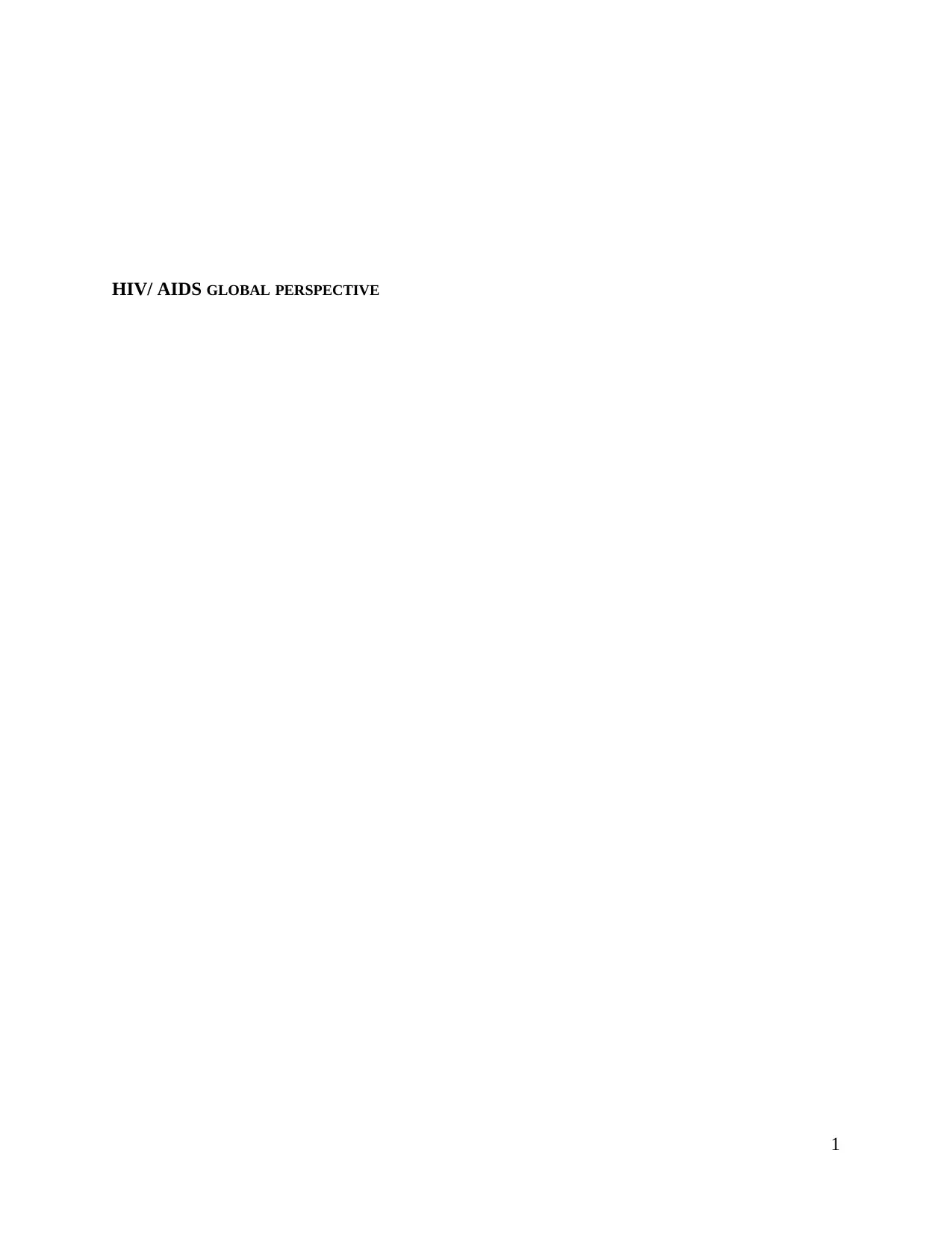
HIV/ AIDS GLOBAL PERSPECTIVE
1
1
Paraphrase This Document
Need a fresh take? Get an instant paraphrase of this document with our AI Paraphraser
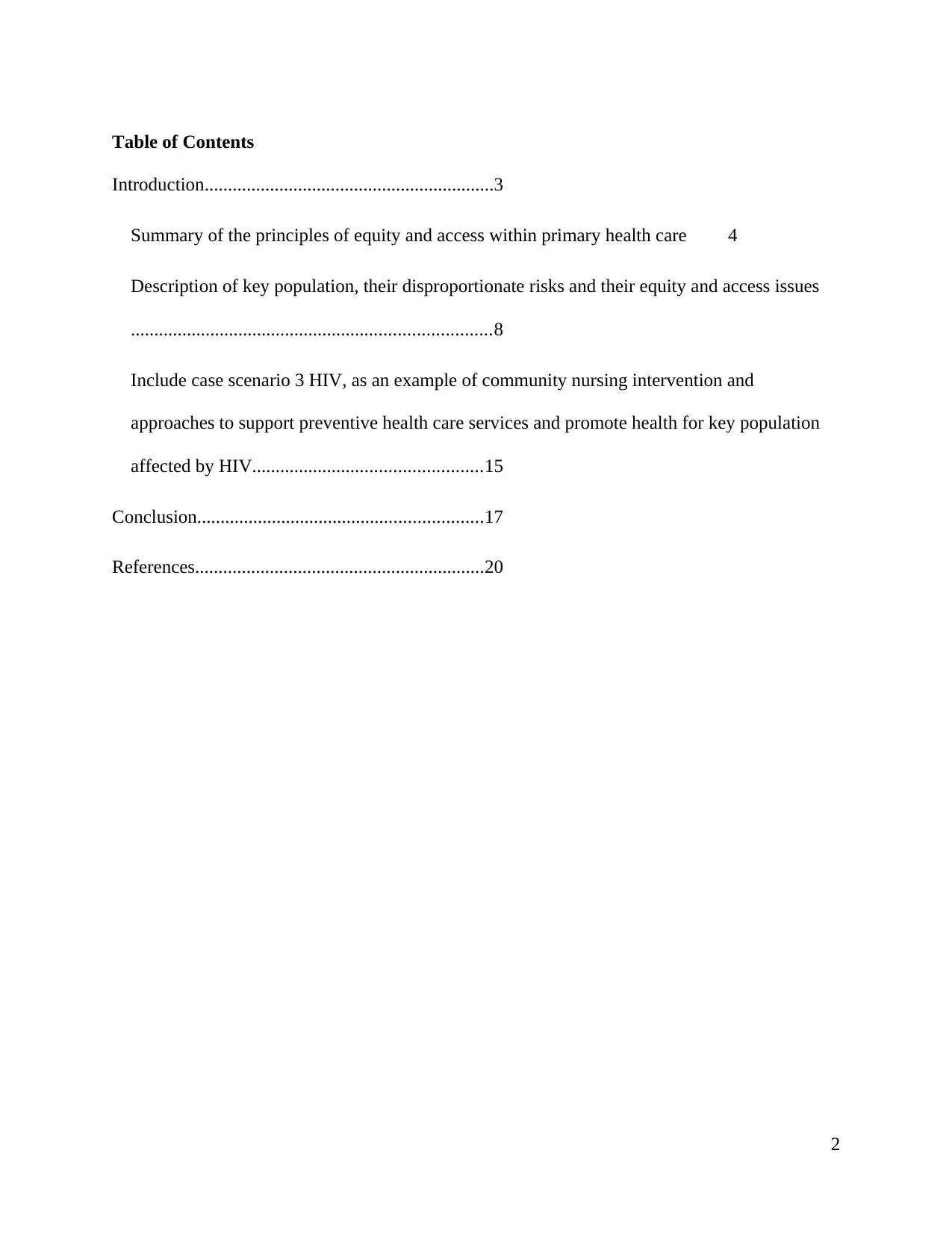
Table of Contents
Introduction..............................................................3
Summary of the principles of equity and access within primary health care 4
Description of key population, their disproportionate risks and their equity and access issues
.............................................................................8
Include case scenario 3 HIV, as an example of community nursing intervention and
approaches to support preventive health care services and promote health for key population
affected by HIV.................................................15
Conclusion.............................................................17
References..............................................................20
2
Introduction..............................................................3
Summary of the principles of equity and access within primary health care 4
Description of key population, their disproportionate risks and their equity and access issues
.............................................................................8
Include case scenario 3 HIV, as an example of community nursing intervention and
approaches to support preventive health care services and promote health for key population
affected by HIV.................................................15
Conclusion.............................................................17
References..............................................................20
2
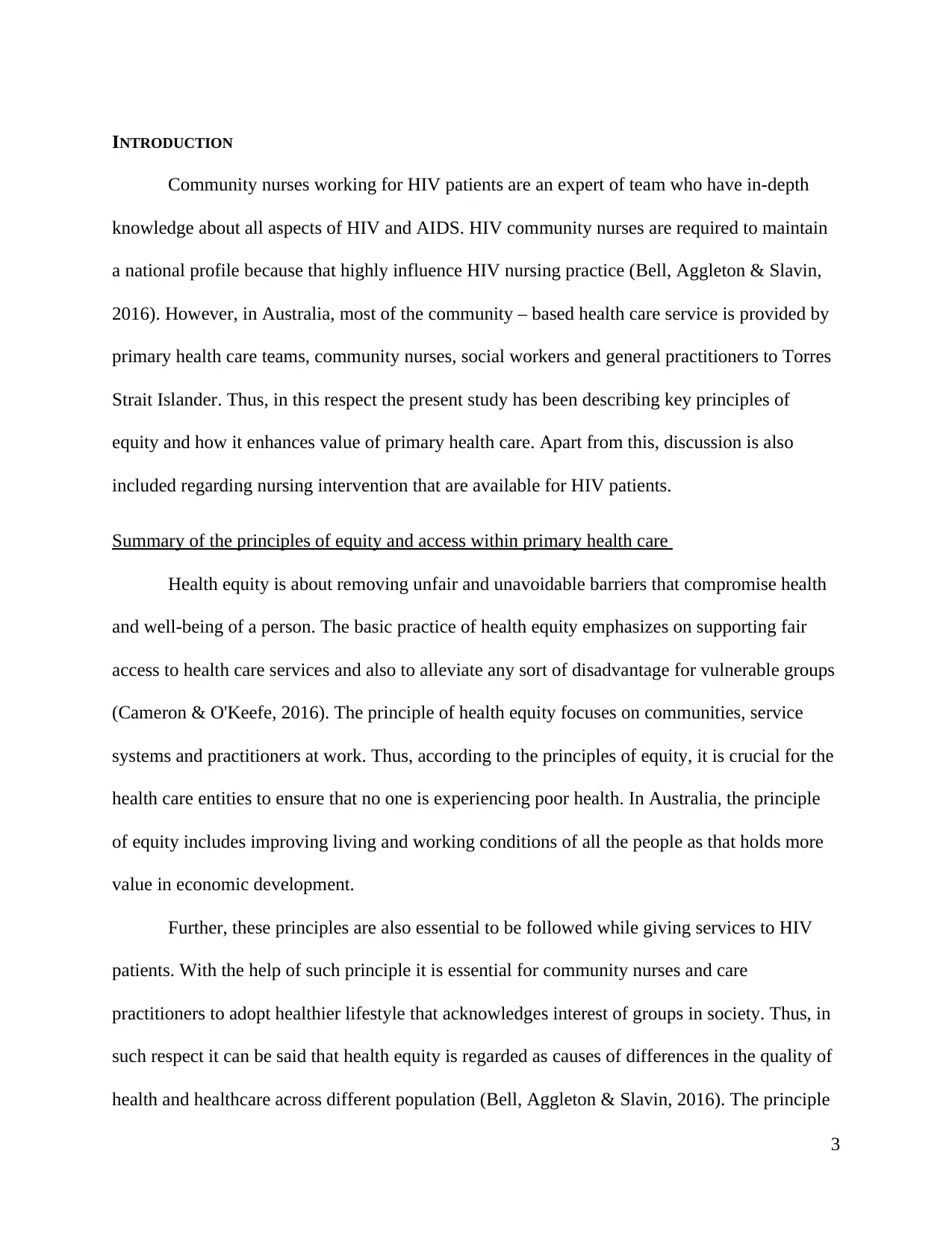
INTRODUCTION
Community nurses working for HIV patients are an expert of team who have in-depth
knowledge about all aspects of HIV and AIDS. HIV community nurses are required to maintain
a national profile because that highly influence HIV nursing practice (Bell, Aggleton & Slavin,
2016). However, in Australia, most of the community – based health care service is provided by
primary health care teams, community nurses, social workers and general practitioners to Torres
Strait Islander. Thus, in this respect the present study has been describing key principles of
equity and how it enhances value of primary health care. Apart from this, discussion is also
included regarding nursing intervention that are available for HIV patients.
Summary of the principles of equity and access within primary health care
Health equity is about removing unfair and unavoidable barriers that compromise health
and well-being of a person. The basic practice of health equity emphasizes on supporting fair
access to health care services and also to alleviate any sort of disadvantage for vulnerable groups
(Cameron & O'Keefe, 2016). The principle of health equity focuses on communities, service
systems and practitioners at work. Thus, according to the principles of equity, it is crucial for the
health care entities to ensure that no one is experiencing poor health. In Australia, the principle
of equity includes improving living and working conditions of all the people as that holds more
value in economic development.
Further, these principles are also essential to be followed while giving services to HIV
patients. With the help of such principle it is essential for community nurses and care
practitioners to adopt healthier lifestyle that acknowledges interest of groups in society. Thus, in
such respect it can be said that health equity is regarded as causes of differences in the quality of
health and healthcare across different population (Bell, Aggleton & Slavin, 2016). The principle
3
Community nurses working for HIV patients are an expert of team who have in-depth
knowledge about all aspects of HIV and AIDS. HIV community nurses are required to maintain
a national profile because that highly influence HIV nursing practice (Bell, Aggleton & Slavin,
2016). However, in Australia, most of the community – based health care service is provided by
primary health care teams, community nurses, social workers and general practitioners to Torres
Strait Islander. Thus, in this respect the present study has been describing key principles of
equity and how it enhances value of primary health care. Apart from this, discussion is also
included regarding nursing intervention that are available for HIV patients.
Summary of the principles of equity and access within primary health care
Health equity is about removing unfair and unavoidable barriers that compromise health
and well-being of a person. The basic practice of health equity emphasizes on supporting fair
access to health care services and also to alleviate any sort of disadvantage for vulnerable groups
(Cameron & O'Keefe, 2016). The principle of health equity focuses on communities, service
systems and practitioners at work. Thus, according to the principles of equity, it is crucial for the
health care entities to ensure that no one is experiencing poor health. In Australia, the principle
of equity includes improving living and working conditions of all the people as that holds more
value in economic development.
Further, these principles are also essential to be followed while giving services to HIV
patients. With the help of such principle it is essential for community nurses and care
practitioners to adopt healthier lifestyle that acknowledges interest of groups in society. Thus, in
such respect it can be said that health equity is regarded as causes of differences in the quality of
health and healthcare across different population (Bell, Aggleton & Slavin, 2016). The principle
3
⊘ This is a preview!⊘
Do you want full access?
Subscribe today to unlock all pages.

Trusted by 1+ million students worldwide
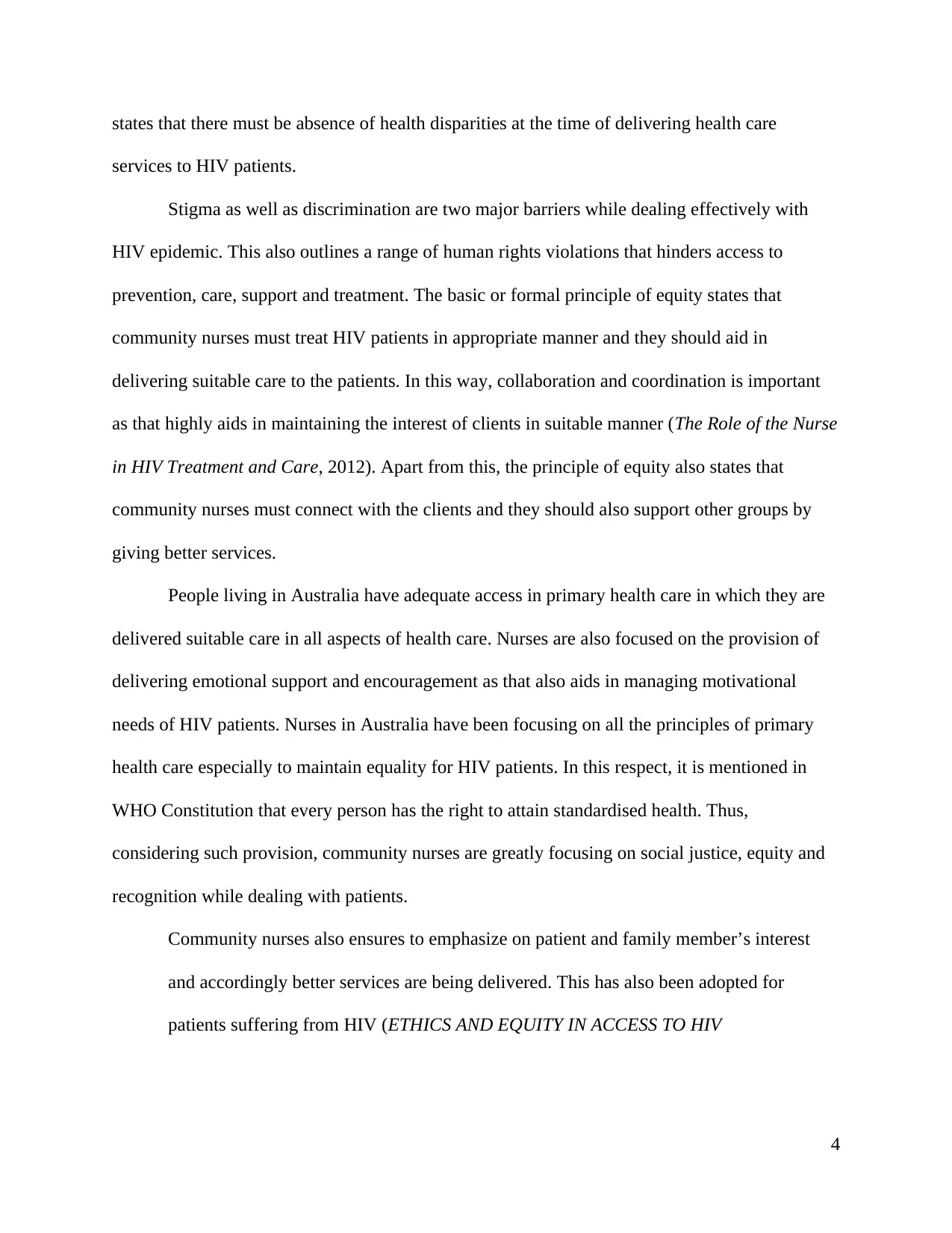
states that there must be absence of health disparities at the time of delivering health care
services to HIV patients.
Stigma as well as discrimination are two major barriers while dealing effectively with
HIV epidemic. This also outlines a range of human rights violations that hinders access to
prevention, care, support and treatment. The basic or formal principle of equity states that
community nurses must treat HIV patients in appropriate manner and they should aid in
delivering suitable care to the patients. In this way, collaboration and coordination is important
as that highly aids in maintaining the interest of clients in suitable manner (The Role of the Nurse
in HIV Treatment and Care, 2012). Apart from this, the principle of equity also states that
community nurses must connect with the clients and they should also support other groups by
giving better services.
People living in Australia have adequate access in primary health care in which they are
delivered suitable care in all aspects of health care. Nurses are also focused on the provision of
delivering emotional support and encouragement as that also aids in managing motivational
needs of HIV patients. Nurses in Australia have been focusing on all the principles of primary
health care especially to maintain equality for HIV patients. In this respect, it is mentioned in
WHO Constitution that every person has the right to attain standardised health. Thus,
considering such provision, community nurses are greatly focusing on social justice, equity and
recognition while dealing with patients.
Community nurses also ensures to emphasize on patient and family member’s interest
and accordingly better services are being delivered. This has also been adopted for
patients suffering from HIV (ETHICS AND EQUITY IN ACCESS TO HIV
4
services to HIV patients.
Stigma as well as discrimination are two major barriers while dealing effectively with
HIV epidemic. This also outlines a range of human rights violations that hinders access to
prevention, care, support and treatment. The basic or formal principle of equity states that
community nurses must treat HIV patients in appropriate manner and they should aid in
delivering suitable care to the patients. In this way, collaboration and coordination is important
as that highly aids in maintaining the interest of clients in suitable manner (The Role of the Nurse
in HIV Treatment and Care, 2012). Apart from this, the principle of equity also states that
community nurses must connect with the clients and they should also support other groups by
giving better services.
People living in Australia have adequate access in primary health care in which they are
delivered suitable care in all aspects of health care. Nurses are also focused on the provision of
delivering emotional support and encouragement as that also aids in managing motivational
needs of HIV patients. Nurses in Australia have been focusing on all the principles of primary
health care especially to maintain equality for HIV patients. In this respect, it is mentioned in
WHO Constitution that every person has the right to attain standardised health. Thus,
considering such provision, community nurses are greatly focusing on social justice, equity and
recognition while dealing with patients.
Community nurses also ensures to emphasize on patient and family member’s interest
and accordingly better services are being delivered. This has also been adopted for
patients suffering from HIV (ETHICS AND EQUITY IN ACCESS TO HIV
4
Paraphrase This Document
Need a fresh take? Get an instant paraphrase of this document with our AI Paraphraser
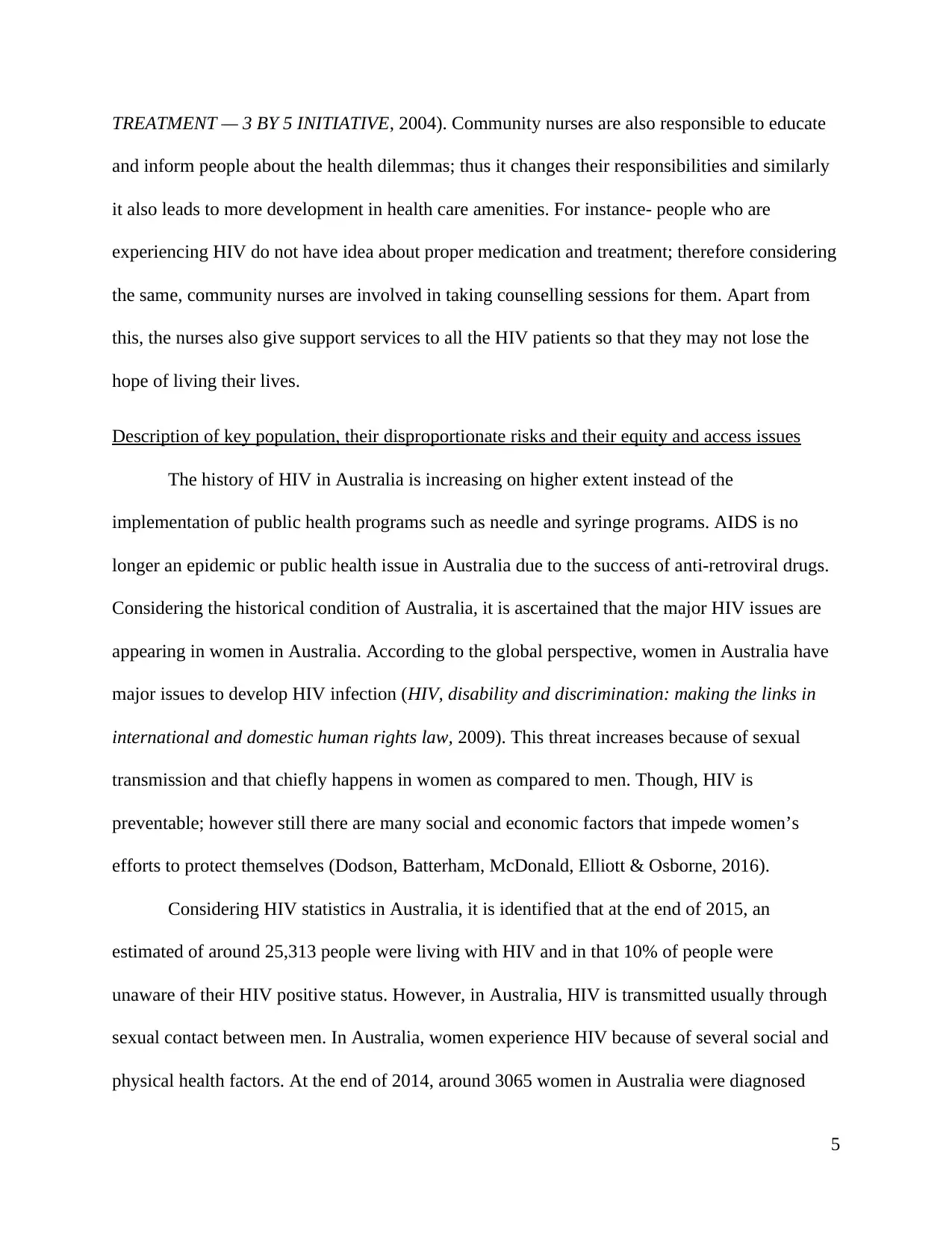
TREATMENT — 3 BY 5 INITIATIVE, 2004). Community nurses are also responsible to educate
and inform people about the health dilemmas; thus it changes their responsibilities and similarly
it also leads to more development in health care amenities. For instance- people who are
experiencing HIV do not have idea about proper medication and treatment; therefore considering
the same, community nurses are involved in taking counselling sessions for them. Apart from
this, the nurses also give support services to all the HIV patients so that they may not lose the
hope of living their lives.
Description of key population, their disproportionate risks and their equity and access issues
The history of HIV in Australia is increasing on higher extent instead of the
implementation of public health programs such as needle and syringe programs. AIDS is no
longer an epidemic or public health issue in Australia due to the success of anti-retroviral drugs.
Considering the historical condition of Australia, it is ascertained that the major HIV issues are
appearing in women in Australia. According to the global perspective, women in Australia have
major issues to develop HIV infection (HIV, disability and discrimination: making the links in
international and domestic human rights law, 2009). This threat increases because of sexual
transmission and that chiefly happens in women as compared to men. Though, HIV is
preventable; however still there are many social and economic factors that impede women’s
efforts to protect themselves (Dodson, Batterham, McDonald, Elliott & Osborne, 2016).
Considering HIV statistics in Australia, it is identified that at the end of 2015, an
estimated of around 25,313 people were living with HIV and in that 10% of people were
unaware of their HIV positive status. However, in Australia, HIV is transmitted usually through
sexual contact between men. In Australia, women experience HIV because of several social and
physical health factors. At the end of 2014, around 3065 women in Australia were diagnosed
5
and inform people about the health dilemmas; thus it changes their responsibilities and similarly
it also leads to more development in health care amenities. For instance- people who are
experiencing HIV do not have idea about proper medication and treatment; therefore considering
the same, community nurses are involved in taking counselling sessions for them. Apart from
this, the nurses also give support services to all the HIV patients so that they may not lose the
hope of living their lives.
Description of key population, their disproportionate risks and their equity and access issues
The history of HIV in Australia is increasing on higher extent instead of the
implementation of public health programs such as needle and syringe programs. AIDS is no
longer an epidemic or public health issue in Australia due to the success of anti-retroviral drugs.
Considering the historical condition of Australia, it is ascertained that the major HIV issues are
appearing in women in Australia. According to the global perspective, women in Australia have
major issues to develop HIV infection (HIV, disability and discrimination: making the links in
international and domestic human rights law, 2009). This threat increases because of sexual
transmission and that chiefly happens in women as compared to men. Though, HIV is
preventable; however still there are many social and economic factors that impede women’s
efforts to protect themselves (Dodson, Batterham, McDonald, Elliott & Osborne, 2016).
Considering HIV statistics in Australia, it is identified that at the end of 2015, an
estimated of around 25,313 people were living with HIV and in that 10% of people were
unaware of their HIV positive status. However, in Australia, HIV is transmitted usually through
sexual contact between men. In Australia, women experience HIV because of several social and
physical health factors. At the end of 2014, around 3065 women in Australia were diagnosed
5
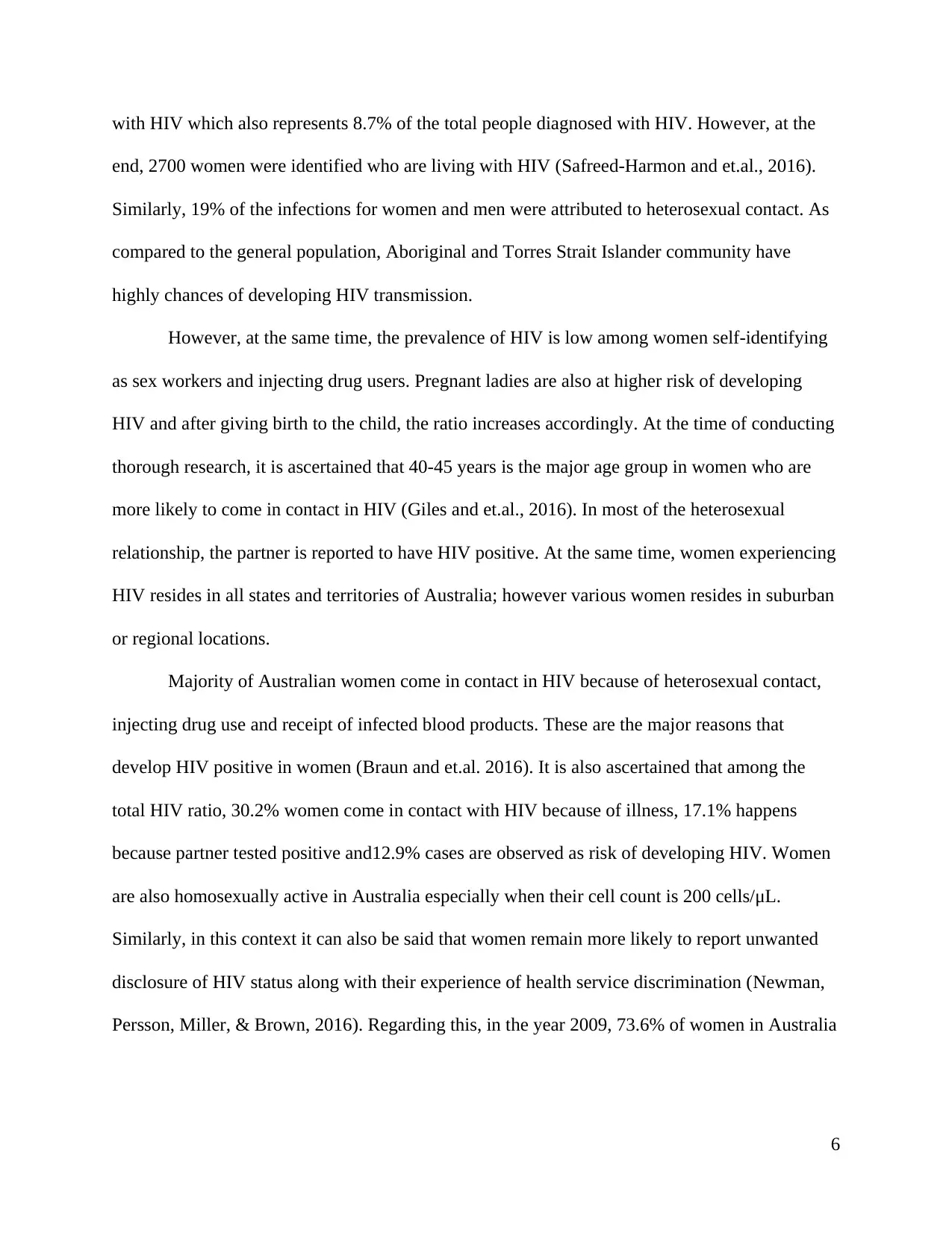
with HIV which also represents 8.7% of the total people diagnosed with HIV. However, at the
end, 2700 women were identified who are living with HIV (Safreed-Harmon and et.al., 2016).
Similarly, 19% of the infections for women and men were attributed to heterosexual contact. As
compared to the general population, Aboriginal and Torres Strait Islander community have
highly chances of developing HIV transmission.
However, at the same time, the prevalence of HIV is low among women self-identifying
as sex workers and injecting drug users. Pregnant ladies are also at higher risk of developing
HIV and after giving birth to the child, the ratio increases accordingly. At the time of conducting
thorough research, it is ascertained that 40-45 years is the major age group in women who are
more likely to come in contact in HIV (Giles and et.al., 2016). In most of the heterosexual
relationship, the partner is reported to have HIV positive. At the same time, women experiencing
HIV resides in all states and territories of Australia; however various women resides in suburban
or regional locations.
Majority of Australian women come in contact in HIV because of heterosexual contact,
injecting drug use and receipt of infected blood products. These are the major reasons that
develop HIV positive in women (Braun and et.al. 2016). It is also ascertained that among the
total HIV ratio, 30.2% women come in contact with HIV because of illness, 17.1% happens
because partner tested positive and12.9% cases are observed as risk of developing HIV. Women
are also homosexually active in Australia especially when their cell count is 200 cells/μL.
Similarly, in this context it can also be said that women remain more likely to report unwanted
disclosure of HIV status along with their experience of health service discrimination (Newman,
Persson, Miller, & Brown, 2016). Regarding this, in the year 2009, 73.6% of women in Australia
6
end, 2700 women were identified who are living with HIV (Safreed-Harmon and et.al., 2016).
Similarly, 19% of the infections for women and men were attributed to heterosexual contact. As
compared to the general population, Aboriginal and Torres Strait Islander community have
highly chances of developing HIV transmission.
However, at the same time, the prevalence of HIV is low among women self-identifying
as sex workers and injecting drug users. Pregnant ladies are also at higher risk of developing
HIV and after giving birth to the child, the ratio increases accordingly. At the time of conducting
thorough research, it is ascertained that 40-45 years is the major age group in women who are
more likely to come in contact in HIV (Giles and et.al., 2016). In most of the heterosexual
relationship, the partner is reported to have HIV positive. At the same time, women experiencing
HIV resides in all states and territories of Australia; however various women resides in suburban
or regional locations.
Majority of Australian women come in contact in HIV because of heterosexual contact,
injecting drug use and receipt of infected blood products. These are the major reasons that
develop HIV positive in women (Braun and et.al. 2016). It is also ascertained that among the
total HIV ratio, 30.2% women come in contact with HIV because of illness, 17.1% happens
because partner tested positive and12.9% cases are observed as risk of developing HIV. Women
are also homosexually active in Australia especially when their cell count is 200 cells/μL.
Similarly, in this context it can also be said that women remain more likely to report unwanted
disclosure of HIV status along with their experience of health service discrimination (Newman,
Persson, Miller, & Brown, 2016). Regarding this, in the year 2009, 73.6% of women in Australia
6
⊘ This is a preview!⊘
Do you want full access?
Subscribe today to unlock all pages.

Trusted by 1+ million students worldwide
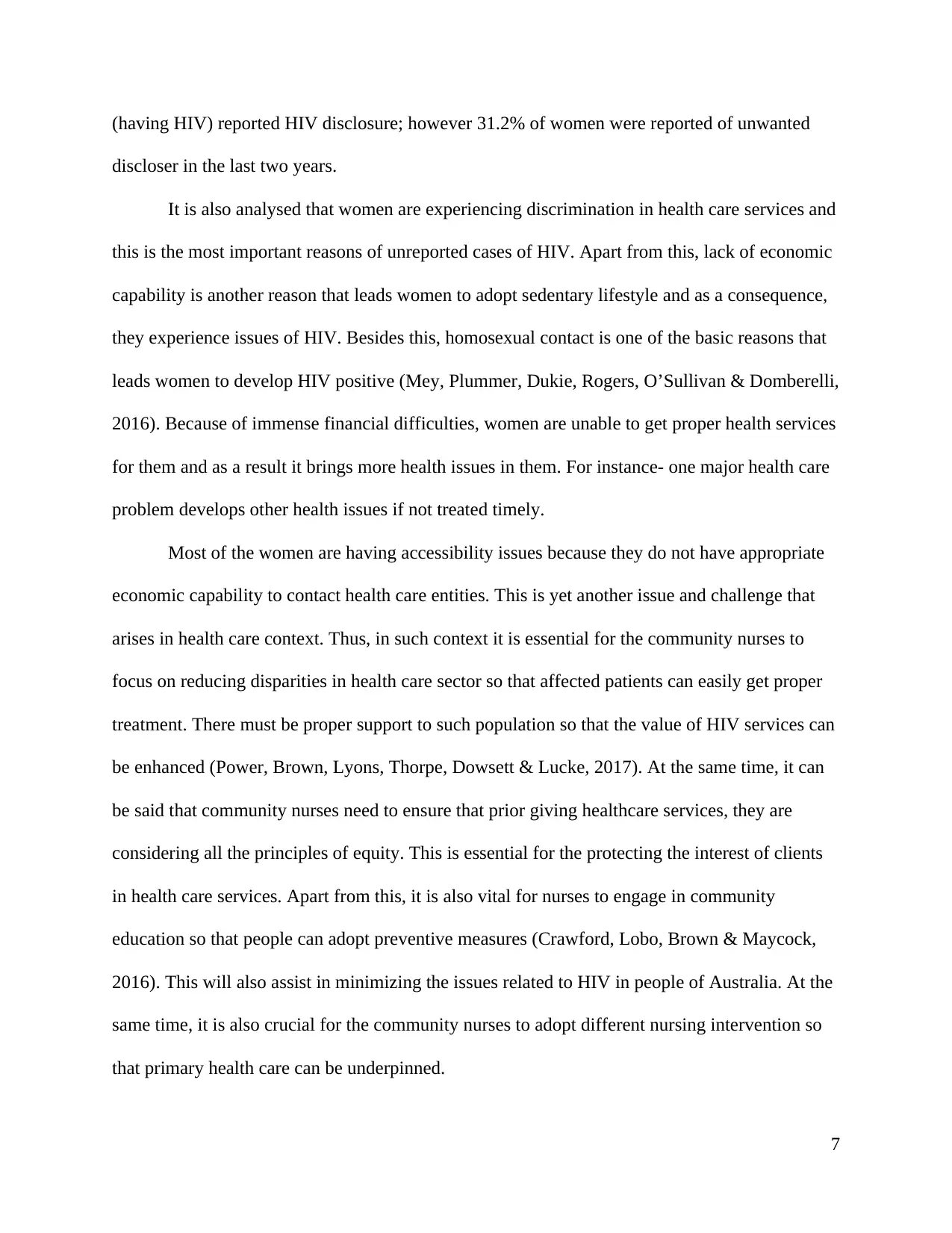
(having HIV) reported HIV disclosure; however 31.2% of women were reported of unwanted
discloser in the last two years.
It is also analysed that women are experiencing discrimination in health care services and
this is the most important reasons of unreported cases of HIV. Apart from this, lack of economic
capability is another reason that leads women to adopt sedentary lifestyle and as a consequence,
they experience issues of HIV. Besides this, homosexual contact is one of the basic reasons that
leads women to develop HIV positive (Mey, Plummer, Dukie, Rogers, O’Sullivan & Domberelli,
2016). Because of immense financial difficulties, women are unable to get proper health services
for them and as a result it brings more health issues in them. For instance- one major health care
problem develops other health issues if not treated timely.
Most of the women are having accessibility issues because they do not have appropriate
economic capability to contact health care entities. This is yet another issue and challenge that
arises in health care context. Thus, in such context it is essential for the community nurses to
focus on reducing disparities in health care sector so that affected patients can easily get proper
treatment. There must be proper support to such population so that the value of HIV services can
be enhanced (Power, Brown, Lyons, Thorpe, Dowsett & Lucke, 2017). At the same time, it can
be said that community nurses need to ensure that prior giving healthcare services, they are
considering all the principles of equity. This is essential for the protecting the interest of clients
in health care services. Apart from this, it is also vital for nurses to engage in community
education so that people can adopt preventive measures (Crawford, Lobo, Brown & Maycock,
2016). This will also assist in minimizing the issues related to HIV in people of Australia. At the
same time, it is also crucial for the community nurses to adopt different nursing intervention so
that primary health care can be underpinned.
7
discloser in the last two years.
It is also analysed that women are experiencing discrimination in health care services and
this is the most important reasons of unreported cases of HIV. Apart from this, lack of economic
capability is another reason that leads women to adopt sedentary lifestyle and as a consequence,
they experience issues of HIV. Besides this, homosexual contact is one of the basic reasons that
leads women to develop HIV positive (Mey, Plummer, Dukie, Rogers, O’Sullivan & Domberelli,
2016). Because of immense financial difficulties, women are unable to get proper health services
for them and as a result it brings more health issues in them. For instance- one major health care
problem develops other health issues if not treated timely.
Most of the women are having accessibility issues because they do not have appropriate
economic capability to contact health care entities. This is yet another issue and challenge that
arises in health care context. Thus, in such context it is essential for the community nurses to
focus on reducing disparities in health care sector so that affected patients can easily get proper
treatment. There must be proper support to such population so that the value of HIV services can
be enhanced (Power, Brown, Lyons, Thorpe, Dowsett & Lucke, 2017). At the same time, it can
be said that community nurses need to ensure that prior giving healthcare services, they are
considering all the principles of equity. This is essential for the protecting the interest of clients
in health care services. Apart from this, it is also vital for nurses to engage in community
education so that people can adopt preventive measures (Crawford, Lobo, Brown & Maycock,
2016). This will also assist in minimizing the issues related to HIV in people of Australia. At the
same time, it is also crucial for the community nurses to adopt different nursing intervention so
that primary health care can be underpinned.
7
Paraphrase This Document
Need a fresh take? Get an instant paraphrase of this document with our AI Paraphraser
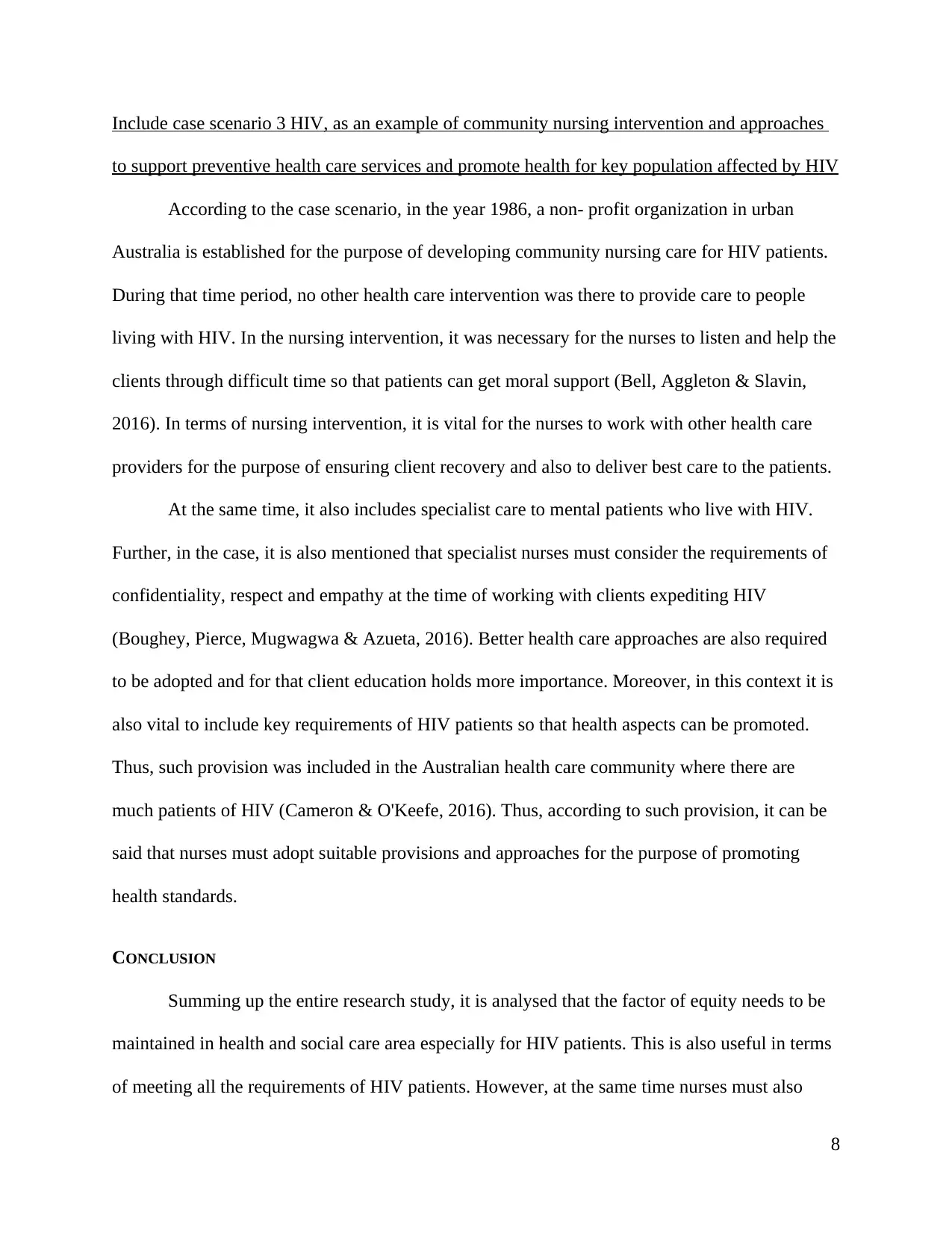
Include case scenario 3 HIV, as an example of community nursing intervention and approaches
to support preventive health care services and promote health for key population affected by HIV
According to the case scenario, in the year 1986, a non- profit organization in urban
Australia is established for the purpose of developing community nursing care for HIV patients.
During that time period, no other health care intervention was there to provide care to people
living with HIV. In the nursing intervention, it was necessary for the nurses to listen and help the
clients through difficult time so that patients can get moral support (Bell, Aggleton & Slavin,
2016). In terms of nursing intervention, it is vital for the nurses to work with other health care
providers for the purpose of ensuring client recovery and also to deliver best care to the patients.
At the same time, it also includes specialist care to mental patients who live with HIV.
Further, in the case, it is also mentioned that specialist nurses must consider the requirements of
confidentiality, respect and empathy at the time of working with clients expediting HIV
(Boughey, Pierce, Mugwagwa & Azueta, 2016). Better health care approaches are also required
to be adopted and for that client education holds more importance. Moreover, in this context it is
also vital to include key requirements of HIV patients so that health aspects can be promoted.
Thus, such provision was included in the Australian health care community where there are
much patients of HIV (Cameron & O'Keefe, 2016). Thus, according to such provision, it can be
said that nurses must adopt suitable provisions and approaches for the purpose of promoting
health standards.
CONCLUSION
Summing up the entire research study, it is analysed that the factor of equity needs to be
maintained in health and social care area especially for HIV patients. This is also useful in terms
of meeting all the requirements of HIV patients. However, at the same time nurses must also
8
to support preventive health care services and promote health for key population affected by HIV
According to the case scenario, in the year 1986, a non- profit organization in urban
Australia is established for the purpose of developing community nursing care for HIV patients.
During that time period, no other health care intervention was there to provide care to people
living with HIV. In the nursing intervention, it was necessary for the nurses to listen and help the
clients through difficult time so that patients can get moral support (Bell, Aggleton & Slavin,
2016). In terms of nursing intervention, it is vital for the nurses to work with other health care
providers for the purpose of ensuring client recovery and also to deliver best care to the patients.
At the same time, it also includes specialist care to mental patients who live with HIV.
Further, in the case, it is also mentioned that specialist nurses must consider the requirements of
confidentiality, respect and empathy at the time of working with clients expediting HIV
(Boughey, Pierce, Mugwagwa & Azueta, 2016). Better health care approaches are also required
to be adopted and for that client education holds more importance. Moreover, in this context it is
also vital to include key requirements of HIV patients so that health aspects can be promoted.
Thus, such provision was included in the Australian health care community where there are
much patients of HIV (Cameron & O'Keefe, 2016). Thus, according to such provision, it can be
said that nurses must adopt suitable provisions and approaches for the purpose of promoting
health standards.
CONCLUSION
Summing up the entire research study, it is analysed that the factor of equity needs to be
maintained in health and social care area especially for HIV patients. This is also useful in terms
of meeting all the requirements of HIV patients. However, at the same time nurses must also
8
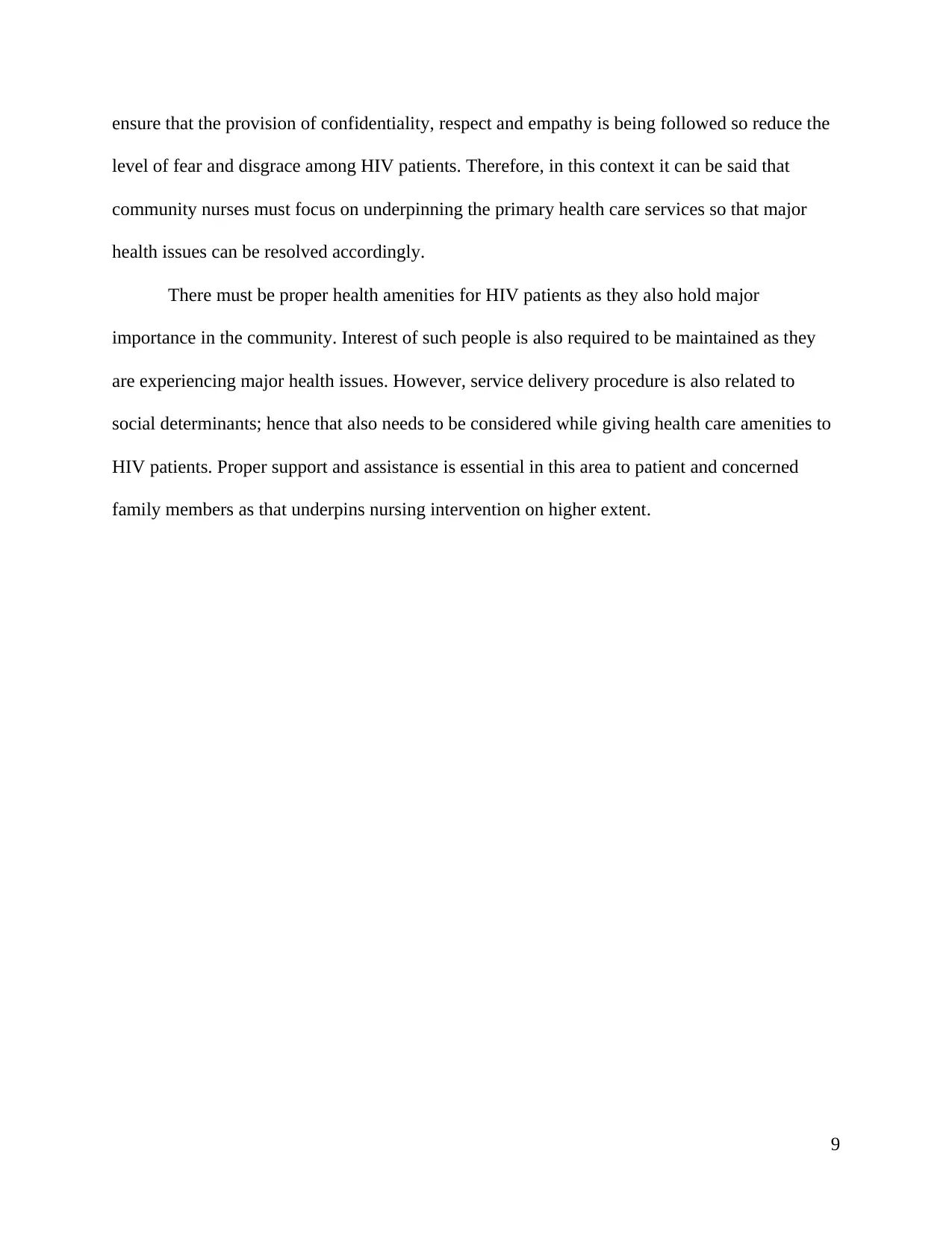
ensure that the provision of confidentiality, respect and empathy is being followed so reduce the
level of fear and disgrace among HIV patients. Therefore, in this context it can be said that
community nurses must focus on underpinning the primary health care services so that major
health issues can be resolved accordingly.
There must be proper health amenities for HIV patients as they also hold major
importance in the community. Interest of such people is also required to be maintained as they
are experiencing major health issues. However, service delivery procedure is also related to
social determinants; hence that also needs to be considered while giving health care amenities to
HIV patients. Proper support and assistance is essential in this area to patient and concerned
family members as that underpins nursing intervention on higher extent.
9
level of fear and disgrace among HIV patients. Therefore, in this context it can be said that
community nurses must focus on underpinning the primary health care services so that major
health issues can be resolved accordingly.
There must be proper health amenities for HIV patients as they also hold major
importance in the community. Interest of such people is also required to be maintained as they
are experiencing major health issues. However, service delivery procedure is also related to
social determinants; hence that also needs to be considered while giving health care amenities to
HIV patients. Proper support and assistance is essential in this area to patient and concerned
family members as that underpins nursing intervention on higher extent.
9
⊘ This is a preview!⊘
Do you want full access?
Subscribe today to unlock all pages.

Trusted by 1+ million students worldwide
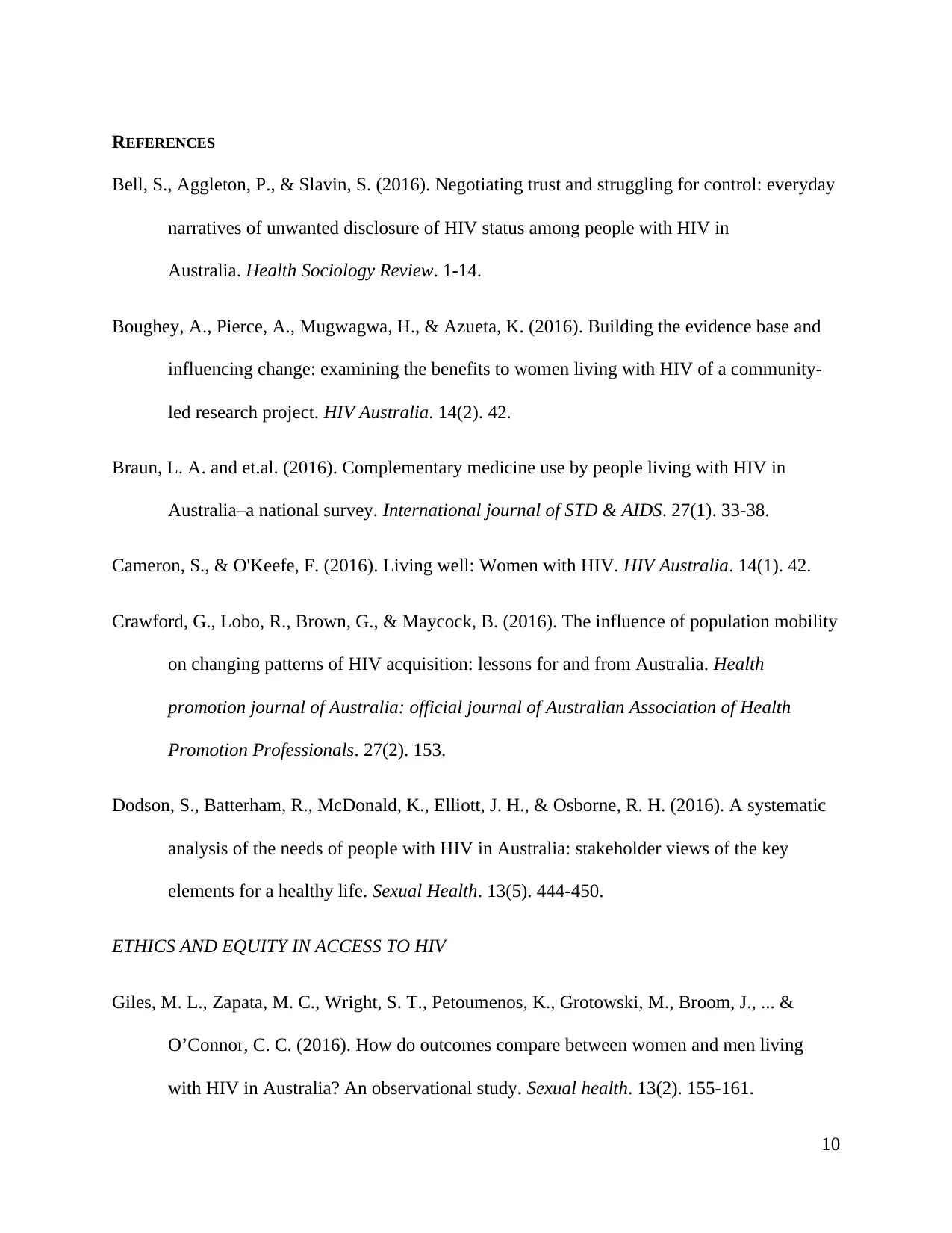
REFERENCES
Bell, S., Aggleton, P., & Slavin, S. (2016). Negotiating trust and struggling for control: everyday
narratives of unwanted disclosure of HIV status among people with HIV in
Australia. Health Sociology Review. 1-14.
Boughey, A., Pierce, A., Mugwagwa, H., & Azueta, K. (2016). Building the evidence base and
influencing change: examining the benefits to women living with HIV of a community-
led research project. HIV Australia. 14(2). 42.
Braun, L. A. and et.al. (2016). Complementary medicine use by people living with HIV in
Australia–a national survey. International journal of STD & AIDS. 27(1). 33-38.
Cameron, S., & O'Keefe, F. (2016). Living well: Women with HIV. HIV Australia. 14(1). 42.
Crawford, G., Lobo, R., Brown, G., & Maycock, B. (2016). The influence of population mobility
on changing patterns of HIV acquisition: lessons for and from Australia. Health
promotion journal of Australia: official journal of Australian Association of Health
Promotion Professionals. 27(2). 153.
Dodson, S., Batterham, R., McDonald, K., Elliott, J. H., & Osborne, R. H. (2016). A systematic
analysis of the needs of people with HIV in Australia: stakeholder views of the key
elements for a healthy life. Sexual Health. 13(5). 444-450.
ETHICS AND EQUITY IN ACCESS TO HIV
Giles, M. L., Zapata, M. C., Wright, S. T., Petoumenos, K., Grotowski, M., Broom, J., ... &
O’Connor, C. C. (2016). How do outcomes compare between women and men living
with HIV in Australia? An observational study. Sexual health. 13(2). 155-161.
10
Bell, S., Aggleton, P., & Slavin, S. (2016). Negotiating trust and struggling for control: everyday
narratives of unwanted disclosure of HIV status among people with HIV in
Australia. Health Sociology Review. 1-14.
Boughey, A., Pierce, A., Mugwagwa, H., & Azueta, K. (2016). Building the evidence base and
influencing change: examining the benefits to women living with HIV of a community-
led research project. HIV Australia. 14(2). 42.
Braun, L. A. and et.al. (2016). Complementary medicine use by people living with HIV in
Australia–a national survey. International journal of STD & AIDS. 27(1). 33-38.
Cameron, S., & O'Keefe, F. (2016). Living well: Women with HIV. HIV Australia. 14(1). 42.
Crawford, G., Lobo, R., Brown, G., & Maycock, B. (2016). The influence of population mobility
on changing patterns of HIV acquisition: lessons for and from Australia. Health
promotion journal of Australia: official journal of Australian Association of Health
Promotion Professionals. 27(2). 153.
Dodson, S., Batterham, R., McDonald, K., Elliott, J. H., & Osborne, R. H. (2016). A systematic
analysis of the needs of people with HIV in Australia: stakeholder views of the key
elements for a healthy life. Sexual Health. 13(5). 444-450.
ETHICS AND EQUITY IN ACCESS TO HIV
Giles, M. L., Zapata, M. C., Wright, S. T., Petoumenos, K., Grotowski, M., Broom, J., ... &
O’Connor, C. C. (2016). How do outcomes compare between women and men living
with HIV in Australia? An observational study. Sexual health. 13(2). 155-161.
10
Paraphrase This Document
Need a fresh take? Get an instant paraphrase of this document with our AI Paraphraser
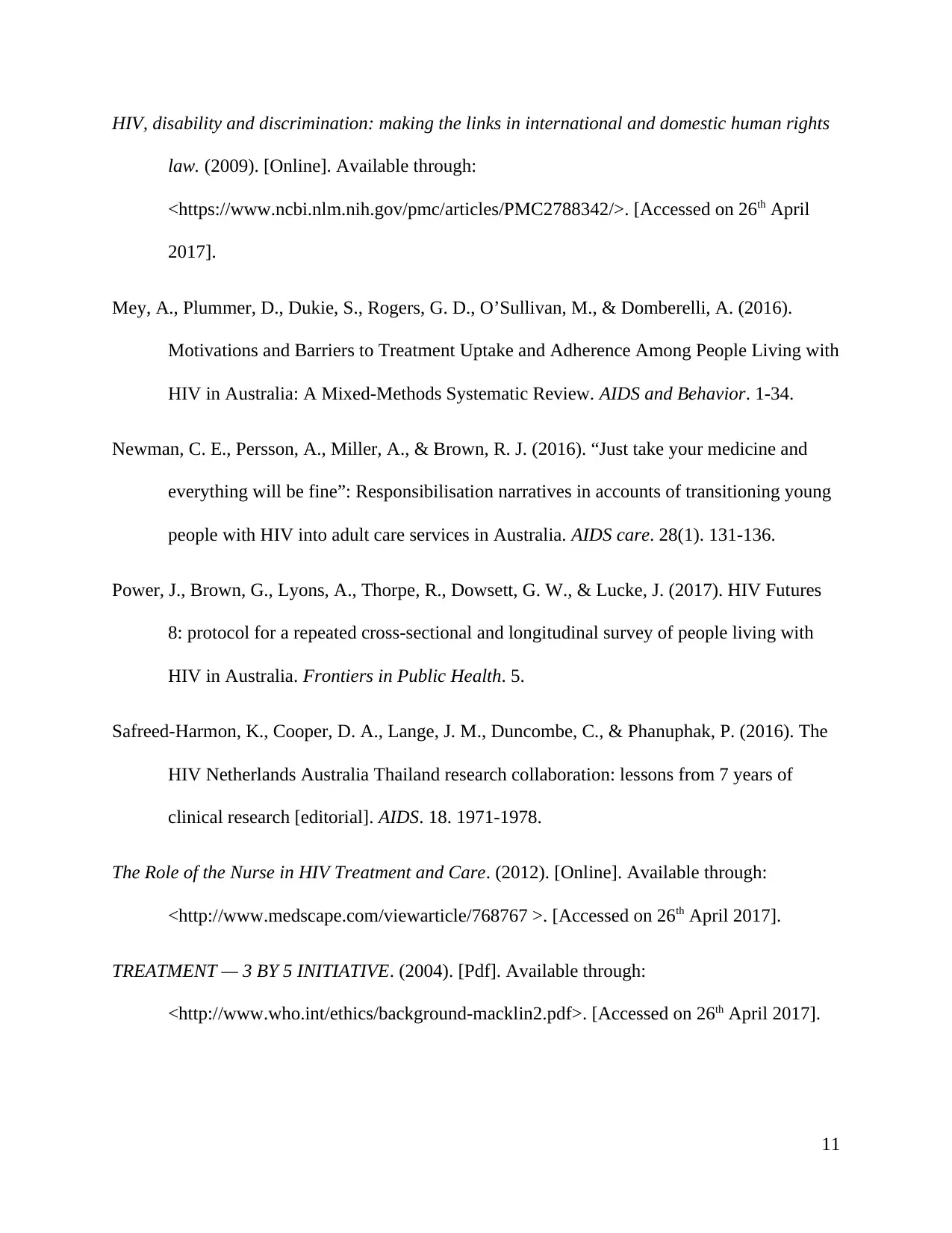
HIV, disability and discrimination: making the links in international and domestic human rights
law. (2009). [Online]. Available through:
<https://www.ncbi.nlm.nih.gov/pmc/articles/PMC2788342/>. [Accessed on 26th April
2017].
Mey, A., Plummer, D., Dukie, S., Rogers, G. D., O’Sullivan, M., & Domberelli, A. (2016).
Motivations and Barriers to Treatment Uptake and Adherence Among People Living with
HIV in Australia: A Mixed-Methods Systematic Review. AIDS and Behavior. 1-34.
Newman, C. E., Persson, A., Miller, A., & Brown, R. J. (2016). “Just take your medicine and
everything will be fine”: Responsibilisation narratives in accounts of transitioning young
people with HIV into adult care services in Australia. AIDS care. 28(1). 131-136.
Power, J., Brown, G., Lyons, A., Thorpe, R., Dowsett, G. W., & Lucke, J. (2017). HIV Futures
8: protocol for a repeated cross-sectional and longitudinal survey of people living with
HIV in Australia. Frontiers in Public Health. 5.
Safreed-Harmon, K., Cooper, D. A., Lange, J. M., Duncombe, C., & Phanuphak, P. (2016). The
HIV Netherlands Australia Thailand research collaboration: lessons from 7 years of
clinical research [editorial]. AIDS. 18. 1971-1978.
The Role of the Nurse in HIV Treatment and Care. (2012). [Online]. Available through:
<http://www.medscape.com/viewarticle/768767 >. [Accessed on 26th April 2017].
TREATMENT — 3 BY 5 INITIATIVE. (2004). [Pdf]. Available through:
<http://www.who.int/ethics/background-macklin2.pdf>. [Accessed on 26th April 2017].
11
law. (2009). [Online]. Available through:
<https://www.ncbi.nlm.nih.gov/pmc/articles/PMC2788342/>. [Accessed on 26th April
2017].
Mey, A., Plummer, D., Dukie, S., Rogers, G. D., O’Sullivan, M., & Domberelli, A. (2016).
Motivations and Barriers to Treatment Uptake and Adherence Among People Living with
HIV in Australia: A Mixed-Methods Systematic Review. AIDS and Behavior. 1-34.
Newman, C. E., Persson, A., Miller, A., & Brown, R. J. (2016). “Just take your medicine and
everything will be fine”: Responsibilisation narratives in accounts of transitioning young
people with HIV into adult care services in Australia. AIDS care. 28(1). 131-136.
Power, J., Brown, G., Lyons, A., Thorpe, R., Dowsett, G. W., & Lucke, J. (2017). HIV Futures
8: protocol for a repeated cross-sectional and longitudinal survey of people living with
HIV in Australia. Frontiers in Public Health. 5.
Safreed-Harmon, K., Cooper, D. A., Lange, J. M., Duncombe, C., & Phanuphak, P. (2016). The
HIV Netherlands Australia Thailand research collaboration: lessons from 7 years of
clinical research [editorial]. AIDS. 18. 1971-1978.
The Role of the Nurse in HIV Treatment and Care. (2012). [Online]. Available through:
<http://www.medscape.com/viewarticle/768767 >. [Accessed on 26th April 2017].
TREATMENT — 3 BY 5 INITIATIVE. (2004). [Pdf]. Available through:
<http://www.who.int/ethics/background-macklin2.pdf>. [Accessed on 26th April 2017].
11
1 out of 11
Related Documents
Your All-in-One AI-Powered Toolkit for Academic Success.
+13062052269
info@desklib.com
Available 24*7 on WhatsApp / Email
![[object Object]](/_next/static/media/star-bottom.7253800d.svg)
Unlock your academic potential
Copyright © 2020–2025 A2Z Services. All Rights Reserved. Developed and managed by ZUCOL.





